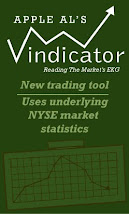Sunday, December 22, 2013
Sunday, 12/22/13 update
The ES appears to be in the 5th wave of an impulse up off the late August lows. If so, then a correction of some significance should be in the cards some time in the next month, but not before a continued push to more new all time highs. A possible target is at ES 1856.00 where wave 5 of the impulse will equal wave 1, as in the below chart.
There are two questionable areas in the long term count, both are highlighted in yellow on the 1st (daily) chart above. The first is the rally sequence from June through mid-September in 2012 which is labeled as Minor Wave 1 (red). That sequence can be labeled as a five wave impulse, but it's a bit awkward, especially at the beginning of the sequence where there was a lot of see-saw action. The second is the correction labeled as Intermediate W4 (purple) in August of this year. It is quite a bit more shallow and of short duration as compared to Intermediate W2 (late March to early June, 2012) - i.e. it's not proportionate. Not saying that it absolutely has to be proportionate, but it is out of the norm.
An alternate to that count that addresses those two issues is below. Look familiar? It's a rework of the hyper-bull count first proposed on Dec 1st. So this would be a possible alternate count that is in play. And if so, it portends quite a bit of bull market yet to ensue before a significant long term top: Inter W3 top followed by Inter W4 and W5 into a Major W3 top, that followed by a Major W4 and W5 into a Primary Wave III top, that followed by a Primary Wave IV and V into a very significant Cycle wave top.
-------------------------------------------------------------------------------------------------------------------------
It's been my experience that a systematic approach to trading is the one that works best. I'm an adherent of the methods developed by Richard Dennis, a very successful commodity trader who did quite well in the 1970's & 1980's. His approach is described in the book "Way of the Turtle" by Curtis M. Faith. Personally I believe this book should be required reading for anyone involved in futures and options trading. His approach had two primary components: a tested trading system and a set of money management rules.
The money management component is just as important as the trading system, but it is the trading system that is of interest here. A good trading system is based on a means of entering and exiting trades that is clearly defined and that yields an excess of winning trades over losers. The conditions upon which a trade is entered and exited is established by extensively back-testing the associated rules. Those rules are thus determined in advance and must be adhered to - any variance from the rules introduces a variable that hasn't been back tested and thus affects the probabilities, and the goal is to trade a system which has been demonstrated to yield a higher probability of profitable trades. The great thing about this approach is that it removes emotion and opinion from the process. It moves the trading effort from gunslinger mode to cool headed poker player mode. Of course, if you'd rather be a gunslinger, go for it babe - I hope it works out for you.
One final note on this subject. I've traded a number of systems using the "turtle" method. None is perfect, but they don't need to be - they just need to possess a demonstrated "edge" - i.e. historical excess of winning trades over losers. The problem is that in each of these systems there seems to be a point where the edge evaporates. Why? I'm not exactly sure, but I believe it's because the only way to guarantee that a given system has a permanent edge is to test that system against a database that is 100% comprehensive - i.e. that is complete from the beginning of time until the end. Obviously impossible, at least for us mere mortals.
blog comments powered by Disqus
Subscribe to:
Post Comments (Atom)



